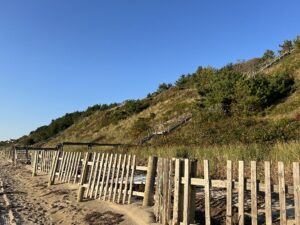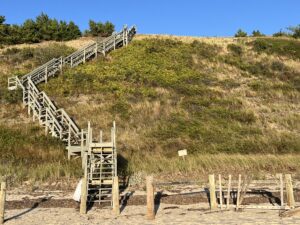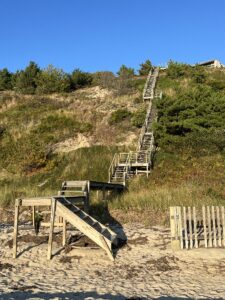TRURO — The Cape Cod Commission voted 11-1 on Sept. 5 to grant a Development of Regional Impact exemption for a proposed 200-foot stairway from a house at 3 Corn Hill Path to the beach.

According to plans by engineering firm Tighe & Bond, the stairs would descend about 88 vertical feet from the coastal bank between Truro’s Great Hollow and Corn Hill beaches. The exemption, valid for three years, declares that the stairs would likely not have an impact outside Truro.
The commission evaluated the project because the stairway was rejected by Truro’s conservation commission, which then missed a legal deadline for filing its opinion in June 2023, opening a path for the owners to move forward under state Dept. of Environmental Protection review instead.
The stairway was permitted under state review standards, according to Truro Conservation Agent Emily Beebe, which then led to its being evaluated by the Cape Cod Commission as a Development of Regional Impact (DRI). The commission does not typically review projects proposed by individual homeowners, and the 11-1 vote was largely based on the lack of potential impact outside Truro.
A Winding Path
Gerald and Marlene Talbot of Concord bought a house on Corn Hill Path in 2020 and first submitted plans to the conservation commission for a stairway on the 1.5-acre property in 2022. The Talbots withdrew their original application later that year and submitted a modified version in April 2023.

The conservation commission voted 4-1 against the stairs on June 5, 2023, finding that the project could not satisfy the standards of state law or Truro’s conservation bylaw.
The commission also voted 4-1 that project documents did not sufficiently prove that construction of the stairway would avoid or mitigate damage to the “sandplain heathland,” a rare habitat found at the top of the coastal bank.
Commissioners also said that deeded rights held by the property owners to a nearby community stairway was an acceptable alternative for beach access.
“I don’t see any necessity for this project, so I’m going to vote no on it,” said commissioner Larry Lown at a June 5 meeting.
“There is an impact, a large impact, on that bank,” said chair Carol Girard-Irwin, who also voted no. “The fact that there is a very useful set of stairs close to this residence” also informed her vote against it, she said.
Because of a misinterpretation of the timeline for issuing the decision, however — “a holiday threw our count off,” Beebe said — the conservation commission’s written denial was not issued within the required 21 days of its vote. It was filed on the 22nd day, at which point the commission had lost its jurisdiction.
As a result, the stairway went to the state Dept. of Environmental Protection for review, which granted approval, Beebe said. That state permit will now control the project, she added.
Regional Impact
The project’s path through state approvals was not simple, though. The stairway crosses a barrier beach, a coastal dune, and a coastal bank, and it is in a community where household income is less than 65 percent of the statewide median, making it proximate to an environmental justice population.

Because of these designations, the project went through review processes laid out by the Mass. Environmental Policy Act and the state’s Executive Office of Energy and Environmental Affairs. An environmental notification form and an environmental impact report (EIR) were both required. They were submitted in February 2024 and certified in April and June, respectively.
Because the project required an EIR, it was also subject to review by the Cape Cod Commission. Michael Kennefick, a land use attorney representing the Talbots, submitted a DRI exemption application for the beach stairs at the end of July.
In comments to the Cape Cod Commission before the vote, Kennefick mentioned that there are already stairways on two adjacent properties and argued there was no regional impact because the proposed stairway would “provide access to this one property owner back and forth from their beach.”
Marshall Puffer, a project manager at Tighe & Bond, told the commission that the stairway project took careful account of the coastal bank and dune.
Helical piles for the stairway would be installed by hand to reduce grade impact, and stair framing would be elevated above flood elevation and vegetation, Puffer said. The lowest section, measuring 15 linear feet, would be removable during the off-season and in case of severe storms, he said.
“We really went through and made sure this was a very stable structure,” said Puffer.
Kevin Grunwald, who represents Truro on the Cape Cod Commission, voted in favor of the DRI exemption because he agreed the stairway had no clear impact outside Truro.
But he told the Independent he still had concerns about the more local effects of the project.
“Anytime you have significant erosion, it’s going to affect property on either side of it,” said Grunwald. “It would be a stretch to say it’s going to go from here all the way to Wellfleet or all the way to Provincetown, but certainly for that area it increases the likelihood” of further erosion, he said.
Mark Borelli, a coastal geologist at the Center for Coastal Studies, told the Independent that he was not familiar with this particular stairway project but that erosion is a serious matter.
“It’s really well understood in the literature that if you put a vertical structure on an eroding beach, you’re going to accelerate erosion,” said Borelli.
“Any manipulation to the beach or the bluffs that are affected by waves can have unintended consequences,” Borelli added.



